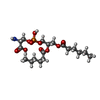[English] 日本語
 Yorodumi
Yorodumi- PDB-9qe2: Mouse otoferlin (216-1931) in complex with an MSP2N2 lipid nanodi... -
+ Open data
Open data
- Basic information
Basic information
| Entry | Database: PDB / ID: 9qe2 | ||||||
|---|---|---|---|---|---|---|---|
| Title | Mouse otoferlin (216-1931) in complex with an MSP2N2 lipid nanodisc (30 mol% DOPS, 10 mol% PI(4,5)P2) | ||||||
 Components Components | Otoferlin | ||||||
 Keywords Keywords | MEMBRANE PROTEIN / Ferlins / otoferlin / lipid nanodisc / synaptic vesicle / exocytosis / auditory nerve / deafness | ||||||
| Function / homology |  Function and homology information Function and homology informationcell projection / sensory perception of sound / synaptic vesicle membrane / presynaptic membrane / basolateral plasma membrane / Golgi membrane / endoplasmic reticulum membrane / metal ion binding Similarity search - Function | ||||||
| Biological species |  | ||||||
| Method | ELECTRON MICROSCOPY / single particle reconstruction / cryo EM / Resolution: 2.3 Å | ||||||
 Authors Authors | Cretu, C. / Moser, T. | ||||||
| Funding support |  Germany, 1items Germany, 1items
| ||||||
 Citation Citation |  Journal: Sci Adv / Year: 2025 Journal: Sci Adv / Year: 2025Title: Structure and function of otoferlin, a synaptic protein of sensory hair cells essential for hearing. Authors: Han Chen / Constantin Cretu / Abigail Trebilcock / Natalia Evdokimova / Norbert Babai / Laura Feldmann / Florian Leidner / Fritz Benseler / Sophia Mutschall / Klara Esch / Csaba Zoltan ...Authors: Han Chen / Constantin Cretu / Abigail Trebilcock / Natalia Evdokimova / Norbert Babai / Laura Feldmann / Florian Leidner / Fritz Benseler / Sophia Mutschall / Klara Esch / Csaba Zoltan Kibedi Szabo / Vladimir Pena / Constantin Pape / Helmut Grubmüller / Nicola Strenzke / Nils Brose / Carolin Wichmann / Julia Preobraschenski / Tobias Moser /   Abstract: Hearing relies upon speedy synaptic transmission of sound information from inner hair cells (IHCs) to spiral ganglion neurons. To accomplish this, IHCs use a sophisticated presynaptic machinery ...Hearing relies upon speedy synaptic transmission of sound information from inner hair cells (IHCs) to spiral ganglion neurons. To accomplish this, IHCs use a sophisticated presynaptic machinery including the multi-C domain protein otoferlin that is affected by human deafness mutations. Otoferlin is essential for IHC exocytosis, but how it binds Ca and the target membrane to serve synaptic vesicle (SV) tethering, docking, and fusion remained unclear. Here, we obtained cryo-electron microscopy structures of otoferlin and employed molecular dynamics simulations of membrane binding. We show that membrane binding by otoferlin involves CB-CG domains and repositions CF and CG domains. Disruption of Ca-binding sites of the CD domain in mice altered synaptic sound encoding and eliminated the Ca cooperativity of IHC exocytosis, indicating that it requires the binding of several Ca-ions by otoferlin. Together, our findings elucidate molecular mechanisms underlying otoferlin-mediated SV docking and support the role of otoferlin as Ca sensor of SV fusion in IHCs. | ||||||
| History |
|
- Structure visualization
Structure visualization
| Structure viewer | Molecule:  Molmil Molmil Jmol/JSmol Jmol/JSmol |
|---|
- Downloads & links
Downloads & links
- Download
Download
| PDBx/mmCIF format |  9qe2.cif.gz 9qe2.cif.gz | 407.7 KB | Display |  PDBx/mmCIF format PDBx/mmCIF format |
|---|---|---|---|---|
| PDB format |  pdb9qe2.ent.gz pdb9qe2.ent.gz | 257 KB | Display |  PDB format PDB format |
| PDBx/mmJSON format |  9qe2.json.gz 9qe2.json.gz | Tree view |  PDBx/mmJSON format PDBx/mmJSON format | |
| Others |  Other downloads Other downloads |
-Validation report
| Summary document |  9qe2_validation.pdf.gz 9qe2_validation.pdf.gz | 1.4 MB | Display |  wwPDB validaton report wwPDB validaton report |
|---|---|---|---|---|
| Full document |  9qe2_full_validation.pdf.gz 9qe2_full_validation.pdf.gz | 1.4 MB | Display | |
| Data in XML |  9qe2_validation.xml.gz 9qe2_validation.xml.gz | 56.4 KB | Display | |
| Data in CIF |  9qe2_validation.cif.gz 9qe2_validation.cif.gz | 86 KB | Display | |
| Arichive directory |  https://data.pdbj.org/pub/pdb/validation_reports/qe/9qe2 https://data.pdbj.org/pub/pdb/validation_reports/qe/9qe2 ftp://data.pdbj.org/pub/pdb/validation_reports/qe/9qe2 ftp://data.pdbj.org/pub/pdb/validation_reports/qe/9qe2 | HTTPS FTP |
-Related structure data
| Related structure data |  53046MC  9se5C  9seaC  9segC  9sflC  9sh0C  9si1C M: map data used to model this data C: citing same article ( |
|---|---|
| Similar structure data | Similarity search - Function & homology  F&H Search F&H Search |
- Links
Links
- Assembly
Assembly
| Deposited unit | 
|
|---|---|
| 1 |
|
- Components
Components
| #1: Protein | Mass: 200417.609 Da / Num. of mol.: 1 Source method: isolated from a genetically manipulated source Details: Cytosolic domain of mouse otoferlin (residues 216-1931) expressed in Sf9 insect cells in frame with an N-terminal twin-StrepII tag. Source: (gene. exp.)   | ||||||
|---|---|---|---|---|---|---|---|
| #2: Chemical | ChemComp-CA / #3: Chemical | Has ligand of interest | Y | Has protein modification | N | |
-Experimental details
-Experiment
| Experiment | Method: ELECTRON MICROSCOPY |
|---|---|
| EM experiment | Aggregation state: PARTICLE / 3D reconstruction method: single particle reconstruction |
- Sample preparation
Sample preparation
| Component | Name: Mouse otoferlin (residues 216-1931) in complex with an MSP2N2 lipid nanodisc (comprising 30 mol% DOPS and 10 mol% PI(4,5)P2) Type: COMPLEX / Entity ID: #1 / Source: RECOMBINANT | ||||||||||||||||||||||||||||||
|---|---|---|---|---|---|---|---|---|---|---|---|---|---|---|---|---|---|---|---|---|---|---|---|---|---|---|---|---|---|---|---|
| Molecular weight | Experimental value: NO | ||||||||||||||||||||||||||||||
| Source (natural) | Organism:  | ||||||||||||||||||||||||||||||
| Source (recombinant) | Organism:  | ||||||||||||||||||||||||||||||
| Buffer solution | pH: 7.5 | ||||||||||||||||||||||||||||||
| Buffer component |
| ||||||||||||||||||||||||||||||
| Specimen | Conc.: 0.92 mg/ml / Embedding applied: NO / Shadowing applied: NO / Staining applied: NO / Vitrification applied: YES Details: Prior to cryo-EM grid preparation, the otoferlin (216-1931)-nanodisc complex was crosslinked in batch on ice with 0.07% (v/v) glutaraldehyde (GA) for 12 min. The reaction was quenched with ...Details: Prior to cryo-EM grid preparation, the otoferlin (216-1931)-nanodisc complex was crosslinked in batch on ice with 0.07% (v/v) glutaraldehyde (GA) for 12 min. The reaction was quenched with 50 mM L-Lysine and L-Arginine and the sample was purified on a Superose 6 10/300 Increase column. | ||||||||||||||||||||||||||||||
| Specimen support | Grid material: COPPER / Grid mesh size: 200 divisions/in. / Grid type: Quantifoil R1.2/1.3 | ||||||||||||||||||||||||||||||
| Vitrification | Instrument: FEI VITROBOT MARK IV / Cryogen name: ETHANE-PROPANE / Humidity: 100 % / Chamber temperature: 277.15 K |
- Electron microscopy imaging
Electron microscopy imaging
| Experimental equipment |  Model: Titan Krios / Image courtesy: FEI Company |
|---|---|
| Microscopy | Model: TFS KRIOS |
| Electron gun | Electron source:  FIELD EMISSION GUN / Accelerating voltage: 300 kV / Illumination mode: FLOOD BEAM FIELD EMISSION GUN / Accelerating voltage: 300 kV / Illumination mode: FLOOD BEAM |
| Electron lens | Mode: BRIGHT FIELD / Nominal magnification: 165000 X / Nominal defocus max: 2300 nm / Nominal defocus min: 1100 nm / Cs: 2.7 mm / C2 aperture diameter: 50 µm / Alignment procedure: COMA FREE |
| Specimen holder | Cryogen: NITROGEN / Specimen holder model: FEI TITAN KRIOS AUTOGRID HOLDER |
| Image recording | Average exposure time: 2.49 sec. / Electron dose: 37.85 e/Å2 / Film or detector model: FEI FALCON IV (4k x 4k) / Num. of grids imaged: 1 / Num. of real images: 12458 / Details: 12448 movies were accepted after curation |
| EM imaging optics | Energyfilter name: TFS Selectris / Energyfilter slit width: 10 eV |
- Processing
Processing
| EM software | Name: PHENIX / Version: 1.21.2_5419 / Category: model refinement | ||||||||||||||||||||||||
|---|---|---|---|---|---|---|---|---|---|---|---|---|---|---|---|---|---|---|---|---|---|---|---|---|---|
| CTF correction | Type: PHASE FLIPPING AND AMPLITUDE CORRECTION | ||||||||||||||||||||||||
| Particle selection | Num. of particles selected: 3390520 | ||||||||||||||||||||||||
| Symmetry | Point symmetry: C1 (asymmetric) | ||||||||||||||||||||||||
| 3D reconstruction | Resolution: 2.3 Å / Resolution method: FSC 0.143 CUT-OFF / Num. of particles: 751004 / Num. of class averages: 1 / Symmetry type: POINT | ||||||||||||||||||||||||
| Atomic model building | B value: 102.02 / Protocol: AB INITIO MODEL / Space: REAL | ||||||||||||||||||||||||
| Atomic model building | Source name: AlphaFold / Type: in silico model | ||||||||||||||||||||||||
| Refinement | Cross valid method: NONE Stereochemistry target values: GeoStd + Monomer Library + CDL v1.2 | ||||||||||||||||||||||||
| Displacement parameters | Biso mean: 103.83 Å2 | ||||||||||||||||||||||||
| Refine LS restraints |
|
 Movie
Movie Controller
Controller








 PDBj
PDBj






